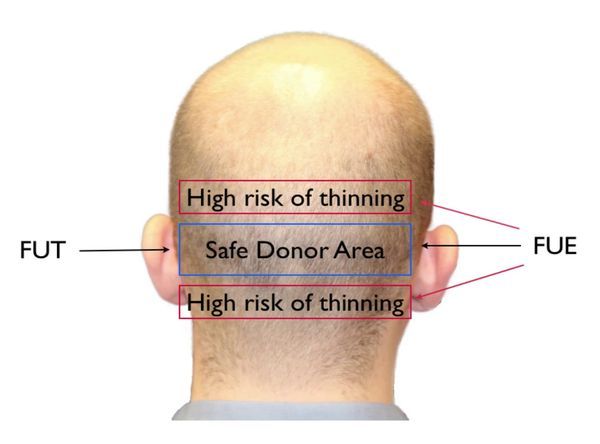Hair transplants have become a popular solution for those struggling with hair loss. If you’re considering a hair transplant, one of the most important factors to understand is the donor area. This is the part of your scalp that provides the healthy hair follicles for transplantation. In this guide, we will explore everything you need to know about the donor area in a hair transplant procedure, from its role to post-procedure care.
What is the Donor Area in a Hair Transplant?
The donor area is the region of your scalp that holds the hair follicles used for the transplant. It is typically located at the back and sides of your head, where the hair is usually thicker and less prone to balding. These areas are chosen for their ability to provide permanent and healthy follicles for transplant.
In hair transplants, the follicular units are harvested from this region. These units are small groups of hair follicles, and their extraction and implantation are vital for successful hair restoration.
Why is the Donor Area Important?

The donor area plays a crucial role in the success of a hair transplant. The health of this area determines the quality and quantity of hair follicles that can be transplanted.
Hair Quality: The follicles from the donor area should be strong and resistant to hair loss, ensuring that the transplanted hair grows back naturally and permanently.
Donor Area Density: The denser the hair in the donor area, the more follicles can be extracted, which directly impacts the results of your hair transplant.
Scar Healing: After the follicles are extracted, the donor area must heal properly to avoid noticeable scars or thinning.
How is the Donor Area Used in Different Hair Transplant Techniques?
There are several hair transplant methods, and the extraction of follicles from the donor area differs based on the technique used:
FUE (Follicular Unit Extraction): In FUE, individual hair follicles are extracted directly from the donor area using a tiny punch tool. This method leaves minimal scarring, as the incisions are tiny and heal quickly.
FUT (Follicular Unit Transplantation): FUT involves removing a strip of scalp from the donor area, from which hair follicles are extracted. This method results in a linear scar, which can be noticeable if your hair is kept very short.
DHI (Direct Hair Implantation): DHI is similar to FUE, but it uses a specialized pen to implant the extracted follicles directly into the recipient area. This method also leaves minimal scarring.
SMART FUE: SMART FUE is an advanced version of FUE, where the extraction process is even more precise, ensuring that the hair follicles are harvested without damaging the donor area.
How Do Doctors Determine if You’re a Good Candidate for a Donor Area Hair Transplant?
Not everyone is a suitable candidate for a hair transplant, and the condition of your donor area is one of the deciding factors. Here’s what doctors look for:
Donor Area Density: A good density of healthy hair in the donor area is crucial. If the donor area is too thin, you may not have enough follicles for a successful transplant.
Scalp Health: The health of your scalp is important for a smooth extraction and healing process. Any underlying scalp conditions need to be treated before a transplant.
Age: Younger patients with early stages of hair loss may be ideal candidates because they have more potential for healthy follicles.
Overall Hair Loss Pattern: Doctors will also consider the progression of your hair loss. Those with diffuse thinning may have a less favorable donor area, reducing the number of follicles available.
What Are the Benefits of a Healthy Donor Area?
A healthy donor area is essential for a successful hair transplant. Here are some key benefits:
Permanent Results: Hair follicles from the donor area are typically resistant to balding, meaning the transplanted hair will continue to grow throughout your life.
Natural Appearance: When the donor area is in good condition, the transplanted hair looks more natural and blends seamlessly with your existing hair.
Faster Recovery: A healthy donor area heals quicker after the extraction process, reducing the risk of complications and scars.
How to Care for Your Donor Area After a Hair Transplant
Proper aftercare is essential for ensuring that the donor area heals correctly and that your hair transplant results are optimal. Here are some tips:
Follow Post-Op Instructions: Your doctor will provide specific instructions regarding washing, medication, and avoiding certain activities. It’s crucial to follow these to ensure proper healing.
Avoid Touching the Donor Area: Do not scratch or pick at the donor area, as it may lead to infections or scarring.
Keep the Area Moisturized: Hydrating the scalp helps in faster recovery.
Avoid Sun Exposure: Protect the donor area from direct sunlight to prevent damage to the healing skin.
Limit Physical Activity: Avoid heavy exercise for the first few weeks to reduce the risk of sweat or strain on the donor area.
5 Frequently Asked Questions About Donor Area in Hair Transplants
1. Can I shave my hair after a hair transplant?
Yes, you can shave your hair, but it’s recommended to wait until the donor area has healed fully, which usually takes a few weeks. Always consult your doctor before shaving.
2. Will there be scars in the donor area?
There may be small scars, especially with FUT, but with methods like FUE and SMART FUE, scars are minimal and often not visible, even with short haircuts.
3. How long does it take for the donor area to heal?
Healing time varies depending on the technique used, but generally, it takes around 7-10 days for the donor area to heal, with full recovery occurring in 2-3 weeks.
4. Can I get a hair transplant if my donor area is weak?
If your donor area is weak, you may not be a suitable candidate for a transplant. Your doctor will assess your suitability for the procedure and may recommend alternative treatments if needed.
5. Is the hair from the donor area permanent?
Yes, the hair follicles taken from the donor area are typically resistant to hair loss, ensuring that the transplanted hair grows permanently.
Conclusion
The donor area in a hair transplant is an essential factor that determines the success of the procedure. By understanding the importance of the donor area and ensuring its health, you can ensure that your hair transplant yields permanent, natural-looking results. If you are considering a hair transplant, consult with an experienced surgeon to assess your donor area and determine the best approach for you.
